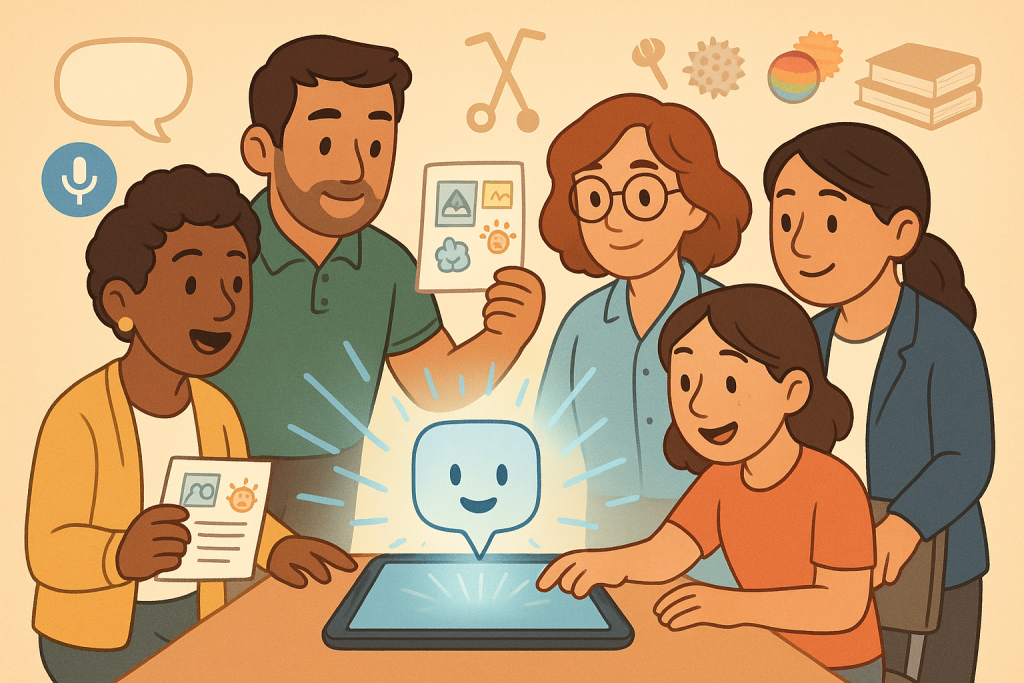
The world of artificial intelligence (AI) continues to evolve at a breathtaking pace, and OpenAI’s recent update to ChatGPT is a prime example. Announced just days ago via the @chatgptricks Instagram page, these changes bring ChatGPT closer to being an everyday assistant for professionals across multiple fields—including speech-language pathologists (SLPs), occupational therapists (OTs), physical therapists (PTs), psychologists, psychomotor therapists, and special educators.
This article explores the key updates and demonstrates how each professional group can apply them to enhance therapy planning, communication, documentation, and client engagement.
1. Image Generation in WhatsApp (via 1-800-ChatGPT)
OpenAI now enables image generation directly within WhatsApp. By messaging 1-800-ChatGPT, professionals can create high-quality AI-generated visuals on the go. This allows therapists and educators to:
- SLPs & OTs: Generate instant visual prompts for vocabulary, articulation, or sequencing tasks.
- PTs & Psychomotor Therapists: Request step-by-step illustrations of exercises or gross motor sequences for children with motor delays.
- Psychologists: Create emotion cards or projective images for therapeutic storytelling.
- Special Educators: Produce custom picture cards for visual schedules or classroom routines.
This seamless integration with WhatsApp is ideal for communicating with families and aides in real-time. As Khanna et al. (2023) note, integrating AI into familiar platforms reduces tech resistance and promotes real-world utility.
2. Custom GPTs on All Models: Personalized AI for Every Budget
Custom GPTs—essentially specialized AI assistants—can now run on any ChatGPT model, including the faster and more affordable GPT-4 mini. This means that:
- SLPs can create a phonological awareness bot for home practice.
- OTs may design a sensory diet planner that generates daily routines based on input.
- PTs could use a balance training GPT with age-adjusted prompts.
- Psychologists can tailor a CBT reflection bot for adolescent clients.
- Special Educators might build a reading comprehension GPT for children with dyslexia.
By enabling personalization across all models, OpenAI is empowering practitioners to innovate without needing premium access (Park & Prabhakaran, 2024).
3. Projects Update: Deep Research, Memory, and Voice
ChatGPT’s new Projects feature is perhaps the most powerful update for therapists and educators. Features include:
- Long-term memory that remembers client profiles and progress.
- Voice input and output for hands-free, accessible communication.
- Document upload and storage for consistent case management.
- Mobile model selector to switch between GPTs efficiently.
Imagine an SLP who uploads weekly session notes and asks ChatGPT to summarize progress or generate session reports. Or a psychologist using voice input to log observations after a session while driving.
According to Xie et al. (2023), memory-enhanced AI significantly improves continuity, reducing time spent on repetitive tasks and increasing focus on clinical reasoning.
Applications Across Professions
| Professional | How to Use the Updates |
| SLPs | Visual cards, home carryover plans, social scripts, and dynamic assessments |
| OTs | Visual schedules, motor planning boards, sensory diet suggestions, adaptive tasks |
| PTs | Exercise demonstrations, movement sequences, and balance/stability progression visuals |
| Psychologists | Therapeutic visuals, journaling prompts, emotion regulation tools, and CBT reflections |
| Psychomotor Therapists | Body scheme illustrations, bilateral coordination games, and session recaps |
| Special Educators | Differentiated content creation, reading supports, visual timetables, and gamified learning |
These updates make AI more practical, inclusive, and therapeutic—not just “smart.” The ability to store information across sessions brings ChatGPT closer to functioning like a case manager or clinical assistant (Mitchell et al., 2023).
Ethical Use in Clinical and Educational Settings
The ethical integration of AI remains paramount. Practitioners must ensure data privacy, informed consent, and age-appropriate content. As noted by the European Commission (2022), AI systems must be transparent, trustworthy, and non-biased.
Custom GPTs used in therapeutic contexts should be evaluated for safety and accuracy, especially when interacting with children or individuals with cognitive challenges. Monitoring and review are essential to avoid over-reliance or misinformation.
Conclusion: A Future of Partnership
OpenAI’s latest ChatGPT updates signal a move toward intelligent collaboration, not automation. These tools are designed to amplify the expertise of professionals—supporting more personalized, efficient, and innovative service delivery.
Whether you’re crafting social-emotional learning tools as a psychologist, adapting motor tasks as a PT, or preparing visuals for an AAC user, these new capabilities bring real-time support to your fingertips. The question is no longer if AI belongs in therapy and education, but how we can best harness it to meet the needs of diverse learners and clients.
References
European Commission. (2022). Ethics guidelines for trustworthy AI. Publications Office of the European Union. https://digital-strategy.ec.europa.eu/en/library/ethics-guidelines-trustworthy-ai
Khanna, R., D’Mello, S., & Caine, K. (2023). Human-AI Collaboration in Education: A Meta-Analysis of Benefits and Barriers. Computers & Education: Artificial Intelligence, 4, 100143. https://doi.org/10.1016/j.caeai.2023.100143
Mitchell, M., Wu, S., Zaldivar, A., Barnes, P., Vasserman, L., Hutchinson, B., … & Gebru, T. (2023). Model Cards for Model Reporting. Communications of the ACM, 66(1), 56–65. https://doi.org/10.1145/3522499
Park, A., & Prabhakaran, V. (2024). Tailoring Lightweight Language Models for Equity and Access. Journal of Artificial Intelligence Research, 76, 321–342. https://doi.org/10.1613/jair.1.13933
Xie, M., Yu, Y., & Yin, Z. (2023). Memory-Augmented Dialogue Systems: A Survey. Journal of Computational Linguistics, 49(2), 221–248. https://doi.org/10.1162/coli_a_00480
